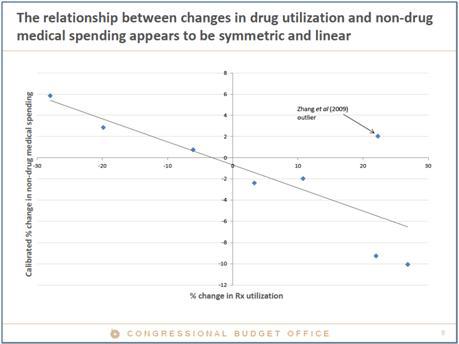Medicines and wider healthcare cost – playing catch up with the US
01.07.13

On some issues, let’s face it, the US is way ahead of us in Europe – we’re playing catch-up. One example is the issue of evidence on how the use of medicines affects the rest of healthcare expenditure. There has simply been more effort and resource in the US devoted to really understanding what drives efficiency. Here are just a few examples:
- Evidence from Medicare part D in the US shows that increased access to medicines reduced use of hospital and other costs[1].
- Expanding drug coverage under Medicare Part D significantly reduced preventable hospitalisations[2]…
- …and led to reductions in use of costly medical care- specialist nurses etc[3]
- Overall, $1 increase in prescription drug spending was associated with a $2.06 reduction in hospital spending[4].
The accumulation of such evidence is starting to have an impact on how US policymakers think about healthcare cost. Last year the Congressional Budget Office (CBO) changed the way it thinks about modelling healthcare budgets. Admirably, it did this based on a thorough review of what the evidence said, not on politics, lobbying or other spurious rationale. It its own words:
“Recently, CBO reviewed dozens of newer studies and determined a body of research now demonstrates a link between changes in prescription drug use and changes in the use of and spending for medical services….
…In estimating the budgetary impact of future legislation or proposals that would directly affect prescription drug use in the Medicare program, CBO will apply an offsetting effect on medical spending.”
Good for them. In Europe, the trend has been the opposite. As Governments have been asked to squeeze healthcare budgets, often the reaction has been to focus on those siloes with the least political fall out – and that often means you-know-what. That’s not to imply that you can’t find efficiencies in medicine spending, of course, but in looking at medicines in isolation the big picture gets lost.
I was sent a presentation yesterday, again from CBO, that reinforces the point beautifully (see below)

The title of this slide couldn’t be clearer: “The relationship between changes in drug utilization and non-drug medical spending appears to be symmetric and linear”. It’s time Europe caught up with this thinking.
________________________________________
[1] J.M McWilliams et al. “Implementation of medicare Part D and non-drug medical spending for elderly adults with limited prior drug coverage” Journal of the American Medical Association, July 27 2011
[2] C.C. Afendulis et al “The impact of medicare Part D on hospitalisation rates” Health services research August 2011
[3] C.C. Afendulis and M.E. Chenew “State-level Impacts of Medicare Part D” American Journal of Managed Care, October 2011 Supplement.
[4] B.Shang and D.P.Goldman “Prescription drug coverage and elderly medical spending” NBER working paper 13358, September 2007
